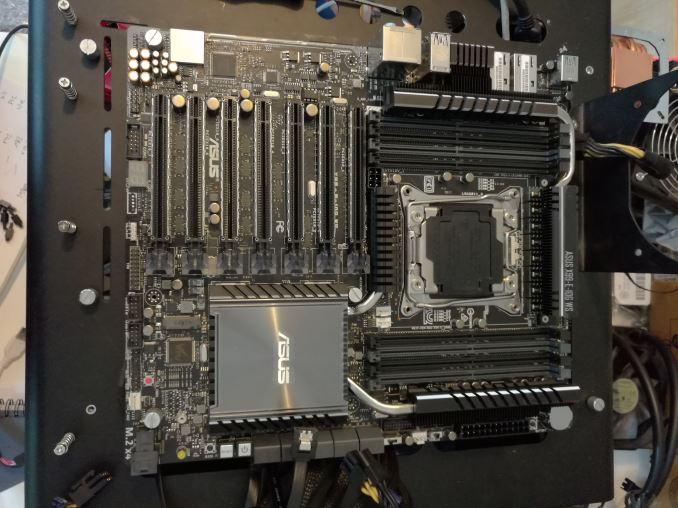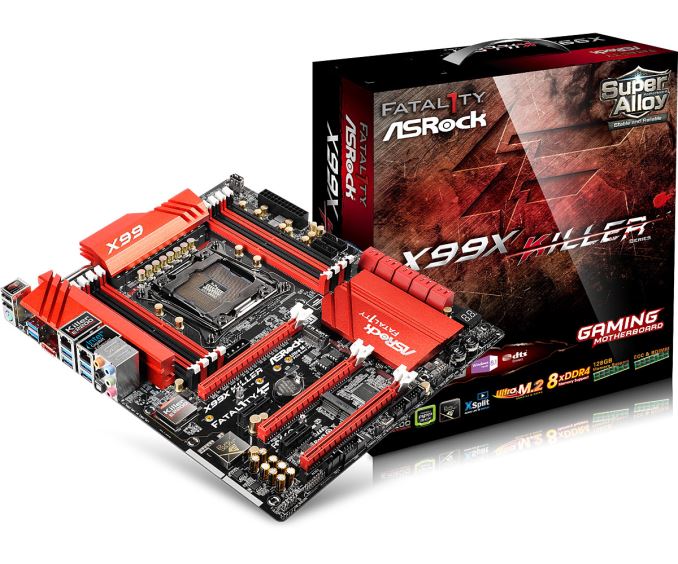The Intel Broadwell-E Review: Core i7-6950X, i7-6900K, i7-6850K and i7-6800K Tested
by Ian Cutress on May 31, 2016 2:01 AM EST- Posted in
- CPUs
- Intel
- Enterprise
- Prosumer
- X99
- 14nm
- Broadwell-E
- HEDT
The Market
At this point in time, Intel is primarily competing with itself. Because the enterprise market requires consistency, the HEDT platform is constrained to that three year, two product cycle, which maintains enough consistency in socket compatibility to keep the enterprise partners happy. When Intel has 95%+ of the HEDT and x86 enterprise market, rather than increasing market share to generate revenue, Intel has to convince users on older systems that their new products are worth the investment. That’s an easy sell in the enterprise market, as time is money and total cost of ownership for a system is typically well documented for cyclical updates.
For HEDT, making that case to prosumers can be difficult. It depends on budgets and how applications are developing, especially when a number of popular professional software packages are (where possible) trying to leverage PCIe accelerators. There will always be a strong market for CPU performance, and there will always be a market for HEDT, depending on the price. But at some point the HEDT and Xeon markets do collide, and the two main factors on this are price and availability.
As mentioned earlier, the newly introduced Broadwell-E Core i7 parts collide in price with a number of Broadwell-EP Xeon parts, which could suggest that Intel wants to push potential prosumers (especially the professional ones) more into systems made by enterprise and workstation partners. These systems are typically sold with appropriate support, and the two platforms differ by a few features. The question becomes about who is buying HEDT: a number of users reading this will be gamers, and will not be interested in workstation sellers.
It’s a strange balance that Intel is trying to strike. Everyone wants more – whether they need it or not is a different conversation – but most enthusiasts say they want more. Intel states that as a company, it supports the gamers and the enthusiasts who want to push their consumer platforms to the fullest, and something like Broadwell-E does that. However a prohibitive price might reduce the potential number of next generation enthusiasts who want to play at the high-end.
X99 Refresh Motherboards
Throughout this month many of the regular motherboard manufacturers have either released, announced, or teased newer "refresh" motherboards using the LGA2011-3 socket and the X99 chipset. We’ve got a base roundup of all the new motherboards coming out of Computex planned, especially as new models are being announced and shown at the show. A couple of these landed on our desk for Broadwell-E testing, such as the MSI X99A Gaming Pro Carbon:
The Carbon is a relatively new brand for MSI’s motherboard range, typically on the high-end models, and this one aims for a deep black aesthetic that is enhanced through the additional LED lighting.
We also have in the ASUS X99-E-10G WS motherboard, ASUS’ high-end workstation and prosumer based motherboard that also integrates an Intel X550-T2 10 gigabit Ethernet chip offering two 10GBase-T ports. We’ve seen this before on the ASRock X99 WS-E/10G, which used the X540-T2, and required eight PCIe 3.0 lanes from the CPU to provide enough bandwidth. We were only able to test the ASUS 10G board for a couple of days before leaving for Computex, and will have a preview up shortly.
ASRock also sent us their X99X Killer, although the courier tried to deliver on a day where I spent 30 minutes gathering stuff for the Computex trip. Go figure. It’ll be ready to test when I get back!
This Review
As with every CPU launch, there are a number of different directions to take our review. In our review of the launch of the consumer Broadwell parts, the i7-5775C and the i5-5675C we examined the generational update over previous architectures, and thus won’t repeat those tests here. We have had almost every high-end desktop CPU since Sandy Bridge-E in-house at some point, although only the latest have been through our most recent benchmark suite. Due to timing, we were able to test all four of the new Broadwell-E processors, and retest the three Haswell-E processors, however we have a more limited dataset for comparison to Ivy Bridge-E, Sandy Bridge-E and Nehalem/Westmere. It will be interesting to see how the CPU performance for the HEDT has adjusted over the last five generations.
The other angle is the recent release of Intel’s Skylake mainstream focused processors, such as the i7-6700K and the i5-6600K, which feature a higher single core frequency but fewer cores and fewer memory channels, or the mainstream enthusiast focused Devil’s Canyon processors released back in July 2014. These have been tested on our latest range of benchmarks, and should make it clear where the latest mainstream-to-HEDT crossover should be.
Test Setup
| Test Setup | |
| Processor | Intel Core i7-6950X (10C/20T, 3.0-3.5 GHz) Intel Core i7-6900K (8C/16T, 3.2-3.7 GHz) Intel Core i7-6850K (6C/12T, 3.6-3.8 GHz) Intel Core i7-6800K (6C/12T, 3.4-3.6 GHz, 28 PCIe 3.0) |
| Motherboards | MSI X99A Gaming Pro Carbon |
| Cooling | Cooler Master Nepton 140XL |
| Power Supply | OCZ 1250W Gold ZX Series Corsair AX1200i Platinum PSU |
| Memory | G.Skill RipjawsX DDR4-2400 C15 4x16GB 1.2V |
| Memory Settings | JEDEC @ 2400 |
| Video Cards | ASUS GTX 980 Strix 4GB MSI R9 290X Gaming 4G MSI GTX 770 Lightning 2GB MSI R9 285 Gaming 2G ASUS R7 240 2GB |
| Hard Drive | Crucial MX200 1TB |
| Optical Drive | LG GH22NS50 |
| Case | Open Test Bed |
| Operating System | Windows 7 64-bit SP1 |
Many thanks to...
We must thank the following companies for kindly providing hardware for our test bed:
Thank you to AMD for providing us with the R9 290X 4GB GPUs.
Thank you to ASUS for providing us with GTX 980 Strix GPUs and the R7 240 DDR3 GPU.
Thank you to ASRock and ASUS for providing us with some IO testing kit.
Thank you to Cooler Master for providing us with Nepton 140XL CLCs.
Thank you to Corsair for providing us with an AX1200i PSU.
Thank you to Crucial for providing us with MX200 SSDs.
Thank you to G.Skill and Corsair for providing us with memory.
Thank you to MSI for providing us with the GTX 770 Lightning GPUs.
Thank you to OCZ for providing us with PSUs.
Thank you to Rosewill for providing us with PSUs and RK-9100 keyboards.













205 Comments
View All Comments
Flunk - Tuesday, May 31, 2016 - link
DX12 actually uses the CPU more efficiently so it should make every LESS CPU constrained, not more so.willis936 - Tuesday, May 31, 2016 - link
Well if you want to toss four channels of memory and 28 pcie lanes out the window and just talk about gaming then you should probably keep it in your head that anyone buying these processors over xeons will be overclocking them. You'll likely get identical single threaded performance on the six core parts to the four core parts but just have 2 more cores. If you say more cores doesn't matter in gaming well idk why everyone (including anandtech) is saying this. I play csgo and bf4 @ 1440p120 on a 770/4790k@4.5GHz and while I'm still GPU limited I see all 8 threads get over 70% usage regularly. I have no doubt that even this 4 core single threaded performance king will bottleneck a 1080 in some cases. Intel has slowed down in performance increases and GPUs haven't. The old talk of "you'll always be CPU limited" shouldn't be treated as dogma. Oh and anandtech should consider changing their CPU gaming benchmarks. It's not super helpful to see a bunch of data that shows a dozen CPUs at a dozen scenarios that are all GPU limited. It's not hard to choose realistic CPU limited scenarios.bogda - Tuesday, May 31, 2016 - link
It is difficult now and it has always been difficult finding meaningful, high end, CPU limited gaming benchmarks (unless you are working in Intel marketing/sales). Nobody buys $1000+ processor to run games at 720p.Anybody thinking about buying high end processor for gaming, after seeing meaningful gaming benchmark, should think twice.
P.S. You probably wanted to say "... you will always be GPU limited should not be treated as dogma".
jacklansley97 - Tuesday, May 31, 2016 - link
These aren't meant for gamers anyway. HEDT has always been aimed at content creation, development, and calculation. I don't know why anyone thinks it's a revelation that these chips don't perform better than a quad core for gaming.Impulses - Tuesday, May 31, 2016 - link
Even then, you need to study your needs carefully... For basic photo/Lightroom tasks clock speed actually matters a decent amount and not a lot of tasks scale super well beyond 4 cores... Obviously for things like video encoding more cores will make a huge difference.joex4444 - Tuesday, May 31, 2016 - link
For gaming, no, but that's the thing: PCs can do so much more than just play games.unityole - Tuesday, May 31, 2016 - link
wanted to see more core per core IPC from 6800/6850k vs 4960x and also 5960x vs 6900k. not just because of technology changed also IPC gain from using TB3.0 which probably minimal.Ian Cutress - Tuesday, May 31, 2016 - link
We covered IPC in both our Broadwell and Skylake mainstream desktop reviews:http://www.anandtech.com/show/9483/intel-skylake-r...
landerf - Tuesday, May 31, 2016 - link
That broadwell has edram. This one doesn't.The two things I and a number of others wanted to see from this review were IPC and overclocking for the whole range, as we've already seen from leaks the 10 core was a bad clocker but a lot of people had high hopes for the lower core models.
Ian Cutress - Tuesday, May 31, 2016 - link
That's a fair point. After Computex blows over I'll look into running Broadwell-E with dual channel memory similar to those tests.